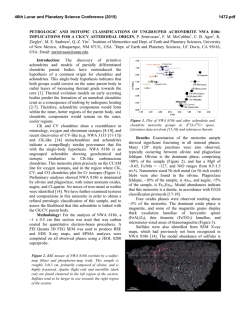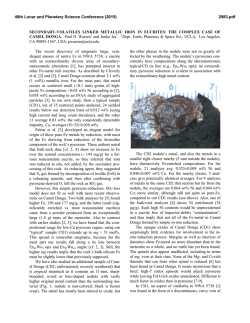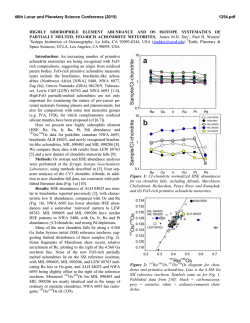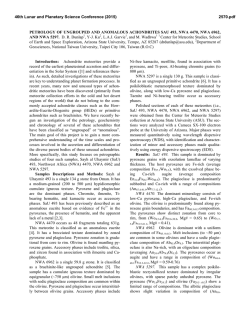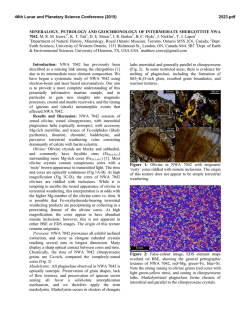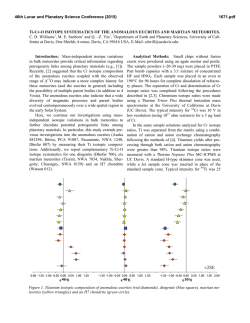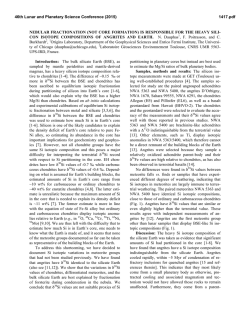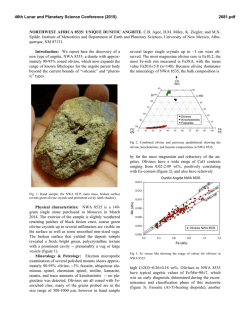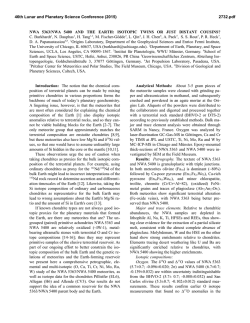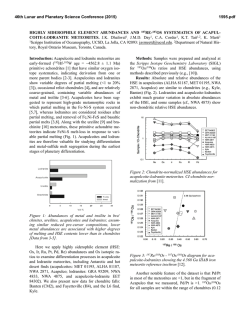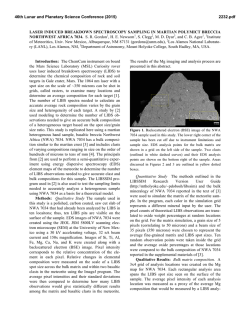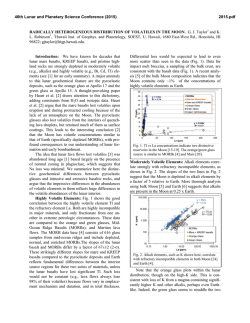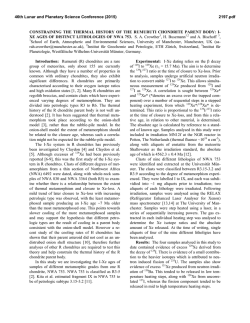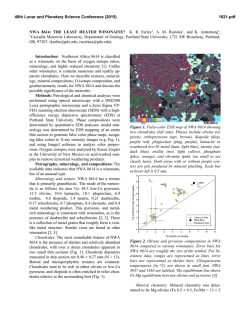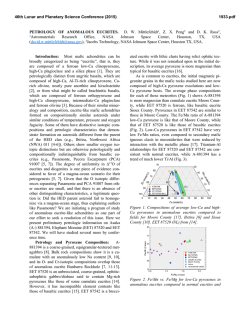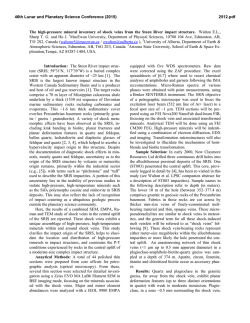
MASKELYNITE IN BASALTIC METEORITES: AN INDICATOR OF
46th Lunar and Planetary Science Conference (2015) 1047.pdf MASKELYNITE IN BASALTIC METEORITES: AN INDICATOR OF SHOCK PRESSURE DURING IMPACT EJECTION FROM PARENT BODIES. Alan E. Rubin, Inst. Geophysics & Planetary Physics; Dept. Earth, Planetary, & Space Sciences; Univ. California, Los Angeles, CA 90095-1567, USA. ([email protected]). Introduction: Basaltic rocks available for laboratory study include samples from the Earth, Moon, Mars and at least seven asteroids – the parent bodies of eucrites (probably 4 Vesta), angrites, mesosiderites, and the ungrouped meteoritic basalts NWA 011 [1], Ibitira and NWA 2824 [2,3], Asuka 881394 [4], NWA 5721 [5], and perhaps others. Shock Effects in Retrieved Lunar Rocks: None of the shock effects in Apollo samples were produced during launch of these rocks off the lunar surface. Consequently, most Apollo mare basalts are weakly shocked or unshocked [6]. Only 3 out of 201 basalts in Apollo 11, 12, 15 and 17 soil contain maskelynite [7-9] (which forms at shock pressures 29 GPa [10]). It appears that few small lunar mare basalts (~1%) were shocked on the surface of the Moon to 29 GPa. Makelynite is also absent in 54 larger Apollo 17 highTi mare basalt samples (average size 364 g) [9]. Lunar Basaltic Meteorites: As of this writing, there appear to be 17 separate lunar basaltic meteorites: Asuka 881757, Dhofar 287, Dhofar 1629, EET 87521, EET 96008, Kalahari 009, LAP 02205 and pairs (LAP 02224, 02226, 02436, 03632, 04841), MIL 05035, NEA 003, NWA 032 and pair (NWA 479), NWA 2727 and pair (NWA 3160), NWA 2977 and pairs (NWA 6950, 8127), NWA 3136, NWA 3170 and pair (NWA 7007), NWA 8632, Yamato 793169, and Yamato 793274. Maskelynite has been reported in five of these rocks: Dhofar 287, NEA 003, MIL 05035, NWA 2727 and NWA 2977. Maskelynite-rich samples constitute ~29% (5/17) of lunar basaltic meteorites. Martian Basaltic Meteorites: As of this writing, there appear to be ~75 separate martian meteorites classified as basaltic shergottites, basaltic breccias, gabbros, diabases, olivine-phyric shergottites and augite basalt. Maskelynite has been reported in all but five of these samples. This indicates that ~93% of martian basalts contain maskelynite and must have been shocked to at least 29 GPa. (The martian basaltic meteorites for which maskelynite has not been reported are NWA 4222, NWA 4797, NWA 6342, Dofar 378, and NWA 7034 (and paired specimens). The first four samples contain plagioclase glass probably formed by large impacts prior to ejection from Mars [e.g., 11].) Eucrites: Eucrites are likely to come from 4 Vesta [12,13], the second largest asteroid (mean diameter 525.4±2 km). Without taking possible pairings into account, there are currently 858 eucrites in the Mete- oritical Bulletin Database (MBD); maskelynite has been reported in 25 of these rocks (~3%). Other Asteroidal Basalts: A total of 23 angrites are currently listed in the MBD; after probable pairings are taken into account, there appear to be 15 separate meteorites. These are unbrecciated rocks [14] that generally have experienced low-to-moderate shock. They do not contain maskelynite. Maskelynite has also not been reported in basaltic clasts from mesosiderites [15] or in the ungrouped basaltic meteorites NWA 011 [1], Ibitira [2], NWA 2824 (which may be related to Ibitira) [3], Asuka 881394 [16] and NWA 5721 [5]. Energy Required for Ejection: The amount of work necessary to launch a sample into interplanetary space can be approximated by: W = G msample Mbody (1/rbody) where W is work, m and M are mass, r is radius, and G is the gravitational constant. For a 1-kg mass, it would take 6.57104 J to escape from Vesta (vesc = 0.36 km s-1), 2.82106 J to escape from the Moon (vesc = 2.38 km s-1), and 1.26107 J to escape from Mars (vesc = 5.03 km s-1). The energy ratios for escape from Vesta, the Moon and Mars are 1:43:192. Because projectiles striking a parent body’s surface roughly follow a power-law mass distribution [17,18], most impact events that eject rocks from a large (100km-diameter) parent body of low-to-moderate porosity are just marginally energetic enough to do that. High-energy impacts are required to launch materials off the surface of large bodies; the larger the body, the more energy is needed to propel rocks to velocities greater than the escape velocity. A collision equivalent to one that barely has enough energy to launch a sample off Vesta will be unable to launch an identical sample off the Moon or Mars. On average, Vesta ejecta will have experienced lower shock pressures than lunar ejecta, and lunar ejecta will have experienced lower shock pressures than martian ejecta. As shown above, maskelynite is rare among retrieved lunar mare basalts (~1%); these rocks were never launched off the Moon. In contrast, the relatively high proportion of maskelynite among lunar basaltic meteorites (~29%) strongly implies that maskelynite was produced in lunar meteorites by high shock pressures associated with impact-excavation and launch. The most straightforward explanation of why maskelynite-rich basalts constitute ~3% of eucrites, ~29% of lunar basaltic meteorites, and ~93% of mar- 46th Lunar and Planetary Science Conference (2015) tian basaltic meteorites is that higher shock pressures are associated with ejection of materials from parent bodies with higher escape velocities. The shock pressure induced in a particle of ejecta is strongly correlated with its ejection velocity from the crater [19,20]. Larger, more-energetic impacts are necessary for ejecting material from Mars than from the Moon or Vesta. There were relatively few impacts involved in launching eucrites off their parent body that typically caused shock pressures 29 GPa in the ejected rocks. Because the percentage of maskelynite-bearing eucrites (~3%) is comparable to that of retrieved Apollo basalts (~1%), and of H (~1%) and LL (~4%) chondrites [this study], it is possible that all of the maskelynite in eucrites was produced on their parent body by hypervelocity collisions prior to launch. In contrast, relatively high proportions of energetic impacts were involved in launching basalts off the Moon and Mars. Compared to lunar meteorites, martian meteorites tend to be larger and appear to be derived from greater depths from larger craters [21]. This is consistent with more-energetic impact events involved in ejecting samples off Mars than off the Moon. Maskeleynite-free basaltic shergottites: Four of the five basaltic shergottites that lack maskelynite instead contain plagioclase glass, likely formed by a large shock event prior to launch [11]. Because materials with lower densities are more strongly heated by a given shock event [10], plagioclase glass (which has a lower density than crystalline plagioclase) will be more strongly heated during ejection from Mars (particularly if it contains vesicles and is thus somewhat porous); it may reach temperatures of 400-500ºC [22]. It will remain as plagioclase glass during launch and not form maskelynite; 400ºC is at or above the temperature that causes annealing of maskelynite in martian meteorites [23]. The crystalline plagioclase associated with plagioclase glass in Dhofar 378 [11,24] may have avoided being transformed into maskelynite because the surrounding glass reached 400-500ºC. Maskelynite-bearing ordinary chondrites: Each of the ordinary-chondrite (OC) groups contains maskelynite-bearing individuals of shock-stage S5. Among well-classified samples for which the shock stage was determined quantitatively, the MBD shows (as of this writing) that 1.3% (67/5342) of H, 10.6% (597/5646) of L and 3.7% (38/1033) of LL chondrites are of shock-stage S5 or higher. The low percentages of maskelynite-bearing individuals among H (~1%) and LL (~4%) chondrites are comparable to those of eucrites (~3%) and unlaunched Apollo basalts (~1%). It is likely that all or nearly all of the maskelynite in these OC samples was produced prior to impact ejection. This is because (a) the OC parent bodies must 1047.pdf have been smaller than Vesta and (b) if they were not appreciably smaller than ~100 km [25], many or most of the collisional events that could launch rocks off the OC asteroids would be just marginally energetic enough to eject these samples. L chondrites are a major exception. The percentage of maskelynite-bearing L chondrites (~11%) is intermediate between that of basalts ejected from Vesta (~3%) and those launched off the Moon (~29%). Because it can be ruled out that the L-chondrite asteroid was substantially larger than Vesta (i.e., of sub-lunar size), it can be surmised that this body experienced a catastrophic collision. This seems to be the case. About two-thirds of L chondrites suffered He losses during a major impact event 470±6 Ma ago [26,27]. Dozens of highly altered L chondrites from this event have been recovered as fossil meteorites in a quarry of Ordovician limestone in Sweden [28]. It is likely that the Lchondrite parent asteroid was disrupted at this time and that the high proportion of maskelynite-bearing samples among L chondrites was produced during this catastrophic event. References: [1] Yamaguchi A. et al. (2002), Science, 296, 334-336. [2] Mittlefehldt D. W. (2005) MPS, 40, 665-677. [3] Bunch T. E. et al. (2009) MPS, 44, A45. [4] Wimpenny J. et al. (2013) LPS, 44, Abstract#2308. [5] Bunch T. E. et al. (2011) LPS, 42, Abstract#1615. [6] Chao E. T. C. et al. (1970) Proc. Apollo 11 LSC, 287-314. [7] Engelhardt W. v. et al. (1971) PLSC, 2, 833-854. [8] Steele I. M. et al. (1972) In The Apollo 15 Lunar Samples, 158-160. [9] Neal C. R. and Taylor L. A. (1993) Catalog of Apollo 17 Rocks, Vol. 2 – Central Valley, Part 1., NASA, Houston, 521 pp. [10] Stöffler D. et al. (1986) GCA, 50, 889-903. [11] Park J. et al. (2008) JGR, 113, 1-12. [12] Consolmagno G. J. and Drake M. J. (1977) GCA, 41, 1271-1282. [13] Binzel R. P. and Xu S. (1993) Science, 260, 186-191. [14] Mittlefehldt D. W. et al. (2002) MPS, 37, 345-369. [15] Rubin A. E. and Mittlefehldt D. W. (1992) GCA, 56, 827-840. [16] Nyquist L. E. et al. (2003) EPSL, 214, 11-25. [17] Davis D. R. et al. (1979) In Asteroids, 528-557. [18] Michel P. and Morbidelli A. (2013) In Impact Cratering: Processes and Products, 21-31. [19] Oberbeck V. R. (1975) RGSP, 13, 337-362. [20] Stöffler D. et al. (1975) JGR, 80, 4062-4077. [21] Warren P. H. (1994) Icarus, 111, 338-363. [22] Fritz J. et al. (2005) MPS, 40, 13931411. [23] Duke M. B. (1968) In Shock Metamorphism of Natural Materials, 613-621. [24] Ikeda Y. et al. (2006) AMR, 19, 20-24. [25] Housen K. R. and Holsapple K. A. (2011) Icarus, 211, 856-875. [26] Heymann D. (1967) Icarus, 6, 189-221. [27] Korochantseva E. V. et al. (2007) MPS, 42, 113-130. [28] Schmitz B. et al. (2001) EPSL, 194, 1-15.
© Copyright 2025

